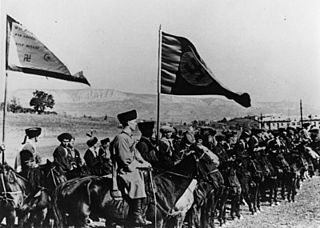This article is a tabular depiction of those generals who held command at the army group echelon or higher on the Western Front of World War II during 1944-1945, and is intended to serve as a reference that can be linked to by other World War II articles. Headquarters and commander names are linked for ease of reference.

The Western Front was a military theatre of World War II encompassing Denmark, Norway, Luxembourg, Belgium, the Netherlands, the United Kingdom, France, Italy, and Germany. World War II military engagements in Southern Europe and elsewhere are generally considered under separate headings. The Western Front was marked by two phases of large-scale combat operations. The first phase saw the capitulation of the Netherlands, Belgium, and France during May and June 1940 after their defeat in the Low Countries and the northern half of France, and continued into an air war between Germany and Britain that climaxed with the Battle of Britain. The second phase consisted of large-scale ground combat, which began in June 1944 with the Allied landings in Normandy and continued until the defeat of Germany in May 1945.

World War II, also known as the Second World War, was a global war that lasted from 1939 to 1945. The vast majority of the world's countries—including all the great powers—eventually formed two opposing military alliances: the Allies and the Axis. A state of total war emerged, directly involving more than 100 million people from over 30 countries. The major participants threw their entire economic, industrial, and scientific capabilities behind the war effort, blurring the distinction between civilian and military resources. World War II was the deadliest conflict in human history, marked by 50 to 85 million fatalities, most of whom were civilians in the Soviet Union and China. It included massacres, the genocide of the Holocaust, strategic bombing, premeditated death from starvation and disease, and the only use of nuclear weapons in war.
| Tenures of command on the Western Front in the Second World War, 1944-1945 [1] [2] [3] [4] | ||||||||||
|---|---|---|---|---|---|---|---|---|---|---|
| Month | SHAEF | 21st Army Group | 12th Army Group | 6th Army Group | OB West (OB Süd after 22 Apr 1945) | Army Group B | Army Group G | Army Group H (OB Nordwest after 7 Apr 1945) | OB Oberrhein | |
| June 1944 | Eisenhower 6 Jun 1944 8 May 1945 | Montgomery 6 Jun 1944 8 May 1945 | von Rundstedt 6 Jun 1944 2 Jul 1944 | Rommel 6 Jun 1944 17 Jul 1944 | Blaskowitz 6 Jun 1944 21 Sep 1944 | |||||
| July 1944 | Bradley 14 Jul 1944 8 May 1945 | von Kluge 2 Jul 1944 16 Aug 1944 | von Kluge 19 Jul 1944 17 Aug 1944 | |||||||
| August 1944 | Devers 1 Aug 1944 8 May 1945 | Model 16 Aug 1944 3 Sep 1944 | Model 17 Aug 1944 21 Apr 1945 | |||||||
| September 1944 | von Rundstedt 3 Sep 1944 11 Mar 1945 | |||||||||
| October 1944 | Balck 21 Sep 1944 24 Dec 1944 | |||||||||
| November 1944 | Student 1 Nov 1944 28 Jan 1945 | |||||||||
| December 1944 | Himmler 10 Dec 1944 23 Jan 1945 Hausser 24 Jan 1945 28 Jan 1945 | |||||||||
| January 1945 | Blaskowitz 24 Dec 1944 29 Jan 1945 | |||||||||
| February 1945 | Hausser 29 Jan 1945 2 Apr 1945 | Blaskowitz 28 Jan 1945 15 Apr 1945 | ||||||||
| March 1945 | Kesselring 11 Mar 1945 8 May 1945 | |||||||||
| April 1945 | Schulz 2 Apr 1945 6 May 1945 | |||||||||
| May 1945 | Busch 15 Apr 1945 7 May 1945 | |||||||||
- 12th Army Group Report of Operations Volume 1, 31 July 1945
- Georg Tessin (CDROM edition), Verbände und Truppen der deutschen Wehrmacht und der Waffen-SS im Zweiten Weltkrieg 1939-1945, Osnabrück: Biblio Verlag, 1967-1998 (17 volumes)
- Mary Williams (compiler), Chronology 1941-1945, Washington: GPO, 1994
- Steven Zaloga, Operation Nordwind 1945, Oxford: Osprey, 2010, ISBN 978-1-84603-683-5

The International Standard Book Number (ISBN) is a numeric commercial book identifier which is intended to be unique. Publishers purchase ISBNs from an affiliate of the International ISBN Agency.





